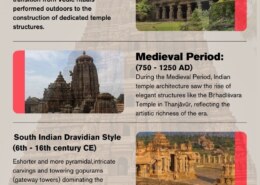What structural advancements and creative expressions were brought about by the Chola dynasty in southern India’s temple architecture?
Sculptural decoration plays a vital role in temple architecture, serving not only as an aesthetic enhancement but also as a medium for conveying cultural, religious, and philosophical themes of the period. The intricate carvings and sculptures found on temples provide insights into the beliefs, valuRead more
Sculptural decoration plays a vital role in temple architecture, serving not only as an aesthetic enhancement but also as a medium for conveying cultural, religious, and philosophical themes of the period. The intricate carvings and sculptures found on temples provide insights into the beliefs, values, and societal dynamics of ancient Indian civilizations. Here’s an analysis of their significance:
1. Religious Narratives and Iconography
- Deities and Mythological Scenes: Temples are adorned with sculptures of various deities, often depicting their attributes and narratives from religious texts. These carvings serve to educate devotees about divine stories and the importance of worship. For instance, the Kandariya Mahadev Temple in Khajuraho features extensive carvings of Hindu gods and goddesses, showcasing their roles in the cosmic order.
- Symbolism: Sculptures often incorporate symbolic elements representing spiritual concepts. For example, the presence of a lotus may symbolize purity and divine beauty, while a serpent can represent protection and power. Such symbols convey deeper philosophical ideas central to the religious practices of the time.
2. Cultural Reflection
- Social Norms and Values: Sculptural decoration often reflects the prevailing social norms, values, and customs of the period. Temples from the Gupta period frequently feature sculptures depicting daily life, social interactions, and cultural activities, providing a window into the societal structure and lifestyle of the time.
- Portrayal of Women: Many temple sculptures depict women in various roles, ranging from divine figures to representations of beauty and fertility. This portrayal indicates the cultural perception of women and their significance in both religious and social contexts.
3. Architectural Integration
- Structural Functionality: Sculptural elements often serve functional purposes within the architectural design. For example, brackets supporting roofs are commonly adorned with intricate carvings, which enhance both the aesthetic and structural aspects of the temple. This integration highlights the craftsmanship and engineering skills of the builders.
- Narrative Friezes: Many temples feature continuous narrative friezes that depict stories or sequences of events, encouraging visitors to engage with the temple’s spiritual messages as they walk around. These friezes not only beautify the temple but also invite contemplation of the narratives portrayed.
4. Regional Variations and Influences
- Diversity in Style: Sculptural styles vary significantly across different regions and periods. For instance, South Indian temples often feature more intricate and detailed sculptures compared to their North Indian counterparts, which may focus more on monumental forms and less intricate ornamentation. This variation reflects local artistic traditions and cultural influences.
- Cross-Cultural Influences: As trade and interactions occurred across regions, sculptural styles also absorbed influences from other cultures. The Chola temples, for example, incorporated elements from local folk traditions and Buddhist art, resulting in a unique blend that enriched the sculptural decoration.
5. Philosophical and Spiritual Themes
- Cosmic Order and Dharma: Sculptures often embody themes related to the concept of dharma (moral order) and cosmic balance. For example, depictions of divine figures engaging in acts of creation, preservation, and destruction illustrate the cyclical nature of life and the importance of maintaining balance within the universe.
- Spiritual Aspirations: Many temple sculptures encourage the viewer to contemplate spiritual ideals, such as devotion (bhakti) and renunciation (sannyasa). They serve as reminders of the divine presence and the aspirational qualities that devotees are encouraged to cultivate.
Conclusion
The sculptural decoration in temple architecture serves as a rich tapestry that weaves together religious, cultural, and philosophical themes of ancient Indian society. Through intricate carvings and iconography, these sculptures not only enhance the visual splendor of temples but also provide valuable insights into the beliefs, values, and everyday life of the period. As such, they remain an essential element in understanding the historical and cultural legacy of ancient Indian civilization.
See less


The Chola dynasty (9th to 13th centuries CE) had a profound influence on temple architecture in southern India, characterized by significant structural innovations and artistic expression. Their contributions are evident in the design, construction techniques, and decorative arts of temples, which pRead more
The Chola dynasty (9th to 13th centuries CE) had a profound influence on temple architecture in southern India, characterized by significant structural innovations and artistic expression. Their contributions are evident in the design, construction techniques, and decorative arts of temples, which played a crucial role in shaping the architectural landscape of the region. Here’s an overview of the Chola influence:
1. Structural Innovations
Vimana Design
Layout and Planning
2. Artistic Expression
Sculptural Decoration
Frescoes and Relief Work
3. Cultural and Religious Significance
Patronage of Arts
Temple as a Socio-Religious Center
4. Legacy and Influence
Conclusion
The Chola dynasty significantly transformed temple architecture in southern India through structural innovations, intricate artistic expressions, and the establishment of temples as central socio-religious institutions. Their legacy is evident in the enduring beauty and complexity of Chola temples, which continue to be celebrated for their architectural brilliance and artistic mastery. These contributions not only reflect the religious fervor of the period but also highlight the cultural richness that characterized the Chola era.
See less